Using multiple monitors with Remote Desktop on Windows 7 Pro
Windows 7 Professional does not natively support multiple monitors when connecting with Remote Desktop. For this feature, users are forced to purchase an expensive upgrade to Windows 7 Enterprise or Ultimate editions, or to a newer Windows release. Furthermore, both the local and remote systems must be running one of the supported versions of Windows.
Once you are used to the convenience and increased efficiency that multiple monitors provide, you just cannot go back to working with a single monitor. So why should you use a single monitor when you're remotely connecting to another computer or virtual machine using Windows 7 Professional? You should not, and this quick guide will show exactly how you can use Remote Desktop with multiple monitors in three easy steps.
Microsoft’s Remote Desktop client (version 6.0 and above) supports spanning across multiple monitors. Only some configurations are supported by Remote Desktop client in span mode. This is explained in a little more detail at:
http://blogs.msdn.com/ts/archive/2006/11/10/multi-monitor-support-in-the...
Specifically, the client needs the following for span mode to work correctly:
o Equal resolution monitors
o Total resolution of all monitors not exceeding 4096 x 2048
o Top-left monitor being the primary
So, with this basic setup, let's jump right in!
Step 1. Check the basics
Make sure both your monitors are using the same resolution and are oriented horizontally. Right click on the desktop. Click Screen Resolution.
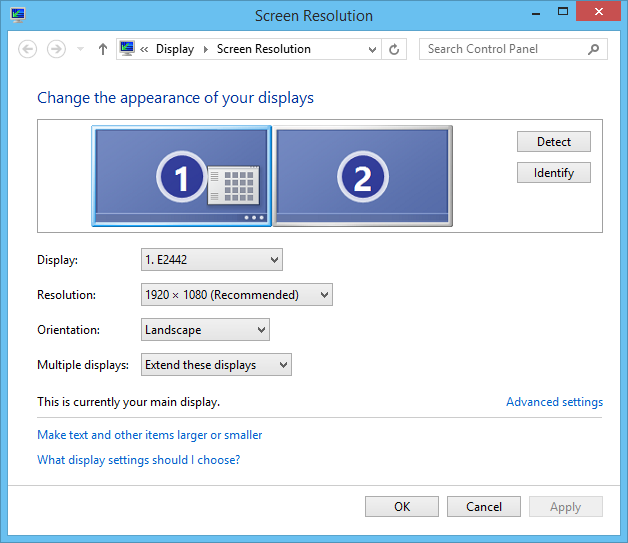
In the Screen Resolution tab, make sure the monitors have the same resolution and are oriented horizontally. If not, adjust your monitor resolution and position so they are. If you are using unequal resolution monitors or a different screen layout, see http://www.splitview.com/node/40
Step 2. Get the right version of Remote Desktop client
Check if you have the right version of Remote Desktop Connection client. You need at least version 6.0
In the Start Menu > Run… dialog, type “mstsc” and hit enter.

The acronym “mstsc” stands for “Microsoft Terminal Services Client” – another name for Remote Desktop Connection client. You can also start it from Start Menu > All Programs > Accessories > Remote Desktop Connection.
The Remote Desktop Connection program should open up.
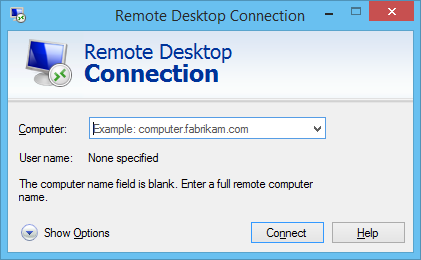
Click the monitor icon in the top-left corner of this dialog, and choose the "About" menu:

This will show the version of the Remote Desktop Connection client. It should be version 6.0 or higher:
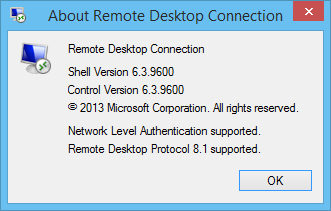
If you have an older version, first download and install a newer version.
Step 3. Connect to remote computer in 'span mode'
To have the Remote Desktop connection client use both your monitors, you need to start it in “span” mode. This is done by giving the following command in the Run dialog:
mstsc /span
Open Start Menu, click Run. Then type in mstsc /span and hit Enter or Click OK
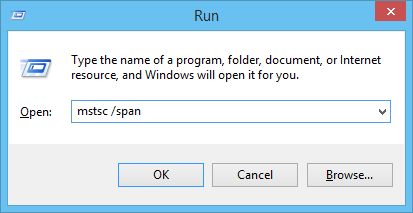
When the Remote Desktop client opens up, enter the remote computer name to which you are connecting, and click Connect.
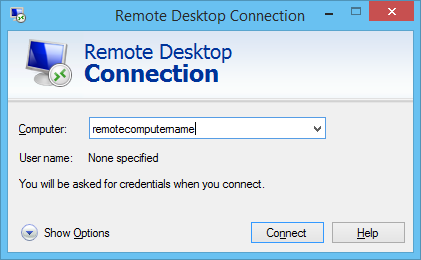
The Remote session should open up and cover both your monitors.
If you do not have SplitView installed on the remote computer, you will run into a few problems with the span mode:
- The Windows taskbar will cover both monitors
- Applications will maximize across both monitors
- Popup dialogs and windows will appear in between the two monitors, half on one monitor and half on the other
- The Windows log on dialog will also appear cut off by the monitor bezels in between the two monitors
This is not the way you expect multi-monitors to work. Instead of increasing efficiency, such a multi-monitor experience will be very inefficient (not to say irritating) to work with, especially when you have to keep moving windows so they do not get chopped off in between the two monitors.
To fix these problems, simply install SplitView in ‘Terminal Server mode’ on the remote computer. ‘Terminal Server mode’ is an install option. SplitView will fix the above mentioned problems and enable a true multi-monitor experience with the spanned remote desktop session.
Once you have this working, you may want to launch the remote session in an easier way instead of typing the ‘mstsc /span’ command everytime.
The next section shows how you can create an “RDP file”, so you can launch a spanned remote desktop session by just double-clicking a file/shortcut.
Creating an RDP file to launch a spanned remote desktop session covering multiple monitors
Create the RDP file
Open Start Menu, click Run. Then type in mstsc /span and hit Enter or Click OK

When the Remote Desktop client opens up, enter the remote computer name to which you are connecting, and DON’T click Connect. Instead, click the Options button.
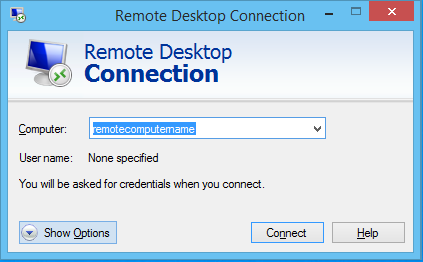
The window will open up to reveal more options:
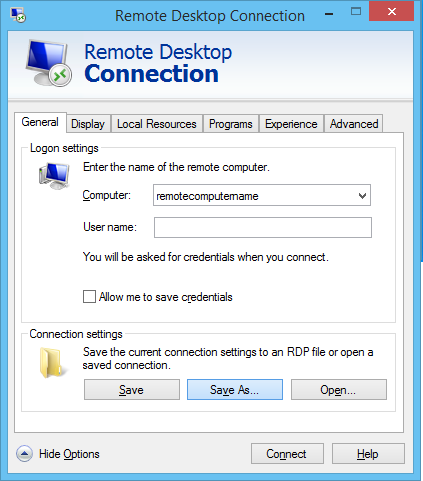
Click the “Save As” button. A “Save As” dialog will open to save the connection settings to a file. Save the file to a known folder, and with a name like remoteserver.rdp. In this example, let's say we saved it to C:\remoteserver.rdp
Now, close the Remote Desktop Connection program. We are done with this for now.
Editing the RDP file
Open Windows Explorer, and browse to the folder containing the file you just saved (C:\remoteserver.rdp).
Right click the file > choose Open With... menu > Choose Program...
In the Open With dialog, choose Notepad to open the file. Remember to NOT check/enable the “Always use the selected program to open this kind of file” option.
Click OK. The file should open up in Notepad. It is a file with many lines. We need to edit this and add one more line.
In the last line of the file, add the following command and hit Enter:
span monitors:i:1
The file should look something like this (note the last line added manually):

Save the file (File menu > Save) and exit Notepad.
Double click... and connect!
From now on, you can connect to the remote computer using both monitors (in span mode) by just double-clicking this file.
To add a shortcut to your desktop, right click the file, and choose “Send To> Desktop (create shortcut)”. This will place a shortcut to this file on your desktop, and you can just double click the shortcut to remotely connect to the remote computer using multiple monitors in span mode.
- SplitView's blog
- Login to post comments
